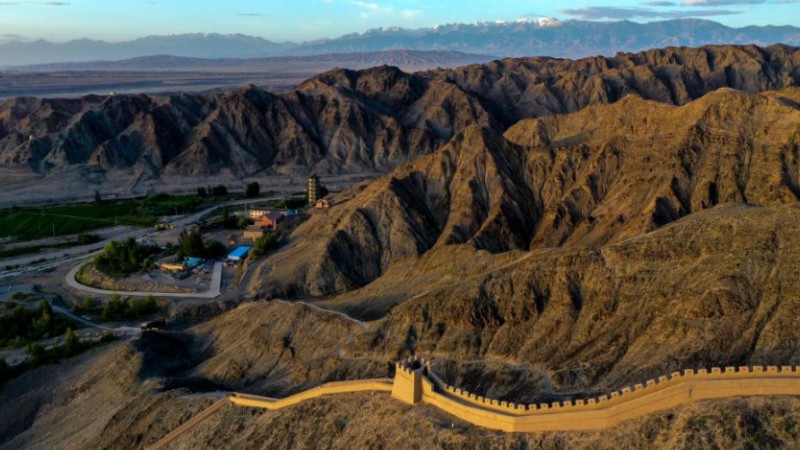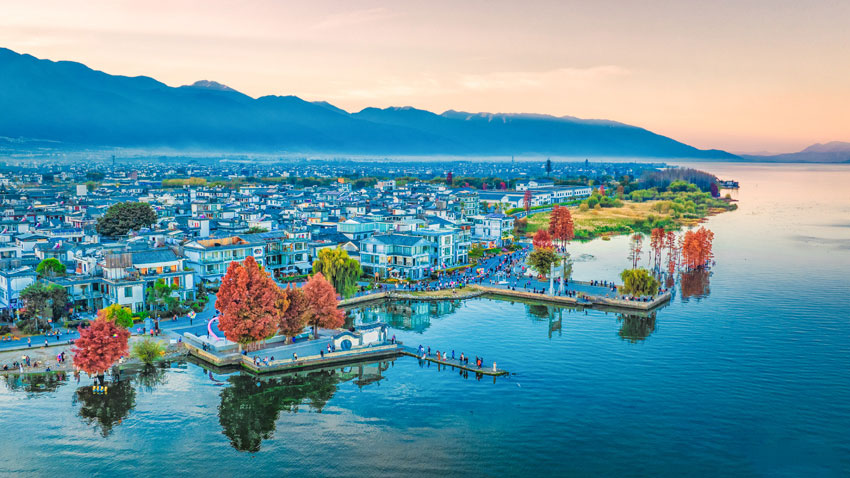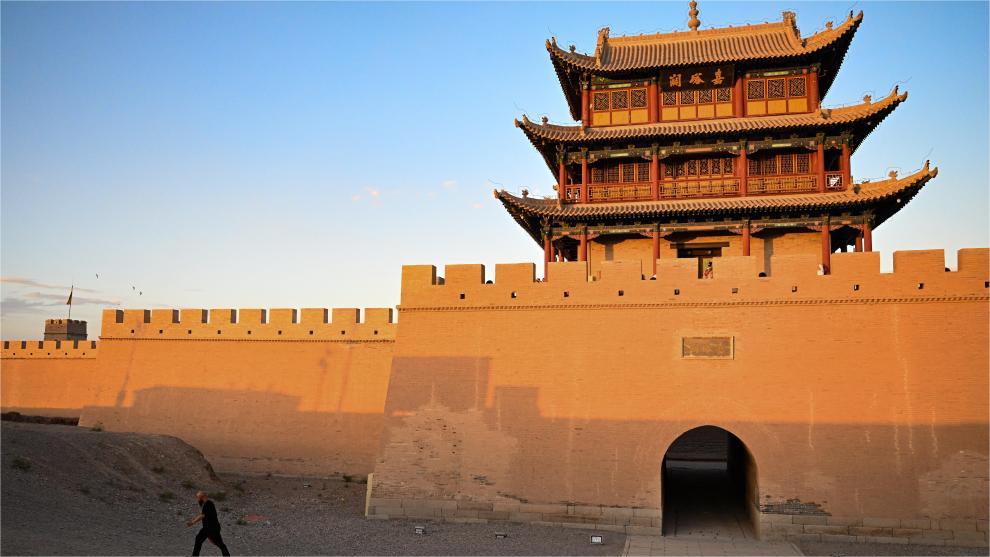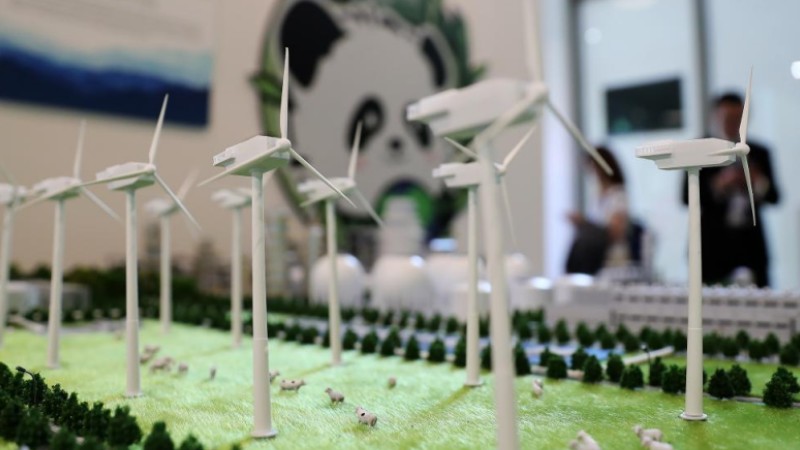Xi kicks off Vietnam visit, calling for China-Vietnam community with a shared future
HANOI, Dec. 12 (Xinhua) -- Chinese President Xi Jinping kicks off a state visit to Vietnam on Tuesday with a call for building a China-Vietnam community with a shared future that carries strategic significance.
"We sincerely hope that our two nations will... steadily promote the building of a community with a shared future that carries strategic significance," Xi, also general secretary of the Communist Party of China (CPC) Central Committee, made the remarks in a signed article published by the Nhan Dan Newspaper of Vietnam.
To steadily promote the building of a China-Vietnam community with a shared future, Xi said the two countries need to maintain strategic communication, make good use of their complementary strengths, step up friendly exchanges, and properly manage differences.
This year marks the 15th anniversary of the China-Vietnam comprehensive strategic cooperative partnership. The two countries have enhanced their common interests with mutually beneficial cooperation, writing together a new chapter in their modernization drive.
LUCRATIVE TRADE
For Nguyen Dinh Tung, general director of Vietnam's Vina T&T Import Export Trading Service Company, a sales slump in the United States and Canada in the first four months of 2023 didn't disturb him very much. The company's export revenues increased by 20 percent thanks to growing shipments to China. The company has signed contracts to export 1,500 containers of durian, 15 tons of the fruit in each container, to China this year, he said.

Vietnamese vendors sell durians in Dongxing, south China's Guangxi Zhuang Autonomous Region, on May 18, 2023. (Xinhua/Hu Xingyu)
In September last year, Vietnamese durians, with longer harvest seasons and lower prices compared to traditionally market-dominant Thai and Malaysian durians, gained market access to China under the Regional Comprehensive Economic Partnership (RCEP) framework. The fruit is widely popular among Chinese consumers, offering new opportunities to durian growers, packers and producers in Vietnam.
Meanwhile, fruits like grapes, citrus and vegetables from south China's Guangxi Zhuang Autonomous Region are also well-received in the Vietnamese market, fostering a sustained momentum in bilateral trade of agricultural products.
International cold-chain train services were launched on the China-Vietnam route last month, carrying fruits and vegetables from southwest China's Yunnan province to northwest Vietnam's Lao Cai province. The new services are expected to inject impetus into common prosperity and high-level opening-up along the railway routes, said Tao Qiang, deputy director of the cargo transport department of China Railway Kunming Bureau Group Co., Ltd., the service operator.
China has remained Vietnam's biggest trading partner for years, while Vietnam has been China's biggest trading partner in the Association of Southeast Asian Nations. In 2022, bilateral trade stood at 234.92 billion U.S. dollars, up 2.1 percent year on year. In the first 10 months of this year, bilateral trade reached 185.1 billion dollars, with China being Vietnam's biggest market for vegetable and fruit exports.
Le Thanh Hoa, deputy director of the Department of Quality, Processing and Market Development under the Ministry of Agriculture and Rural Development, said that it is expected that the bilateral trade volume will hit a new high after Xi's visit, and China will import more high-quality agricultural and sideline products from Vietnam to help its agricultural development.
DEVELOPMENT SYNERGY
In Hanoi, Vietnam's first city metro is running smoothly and carrying commuters through the city crowded with millions of motorbikes and cars. The Chinese-built metro line has witnessed soaring popularity as recent figures showed a 262 percent increase in passengers in the first three months this year from a year earlier.
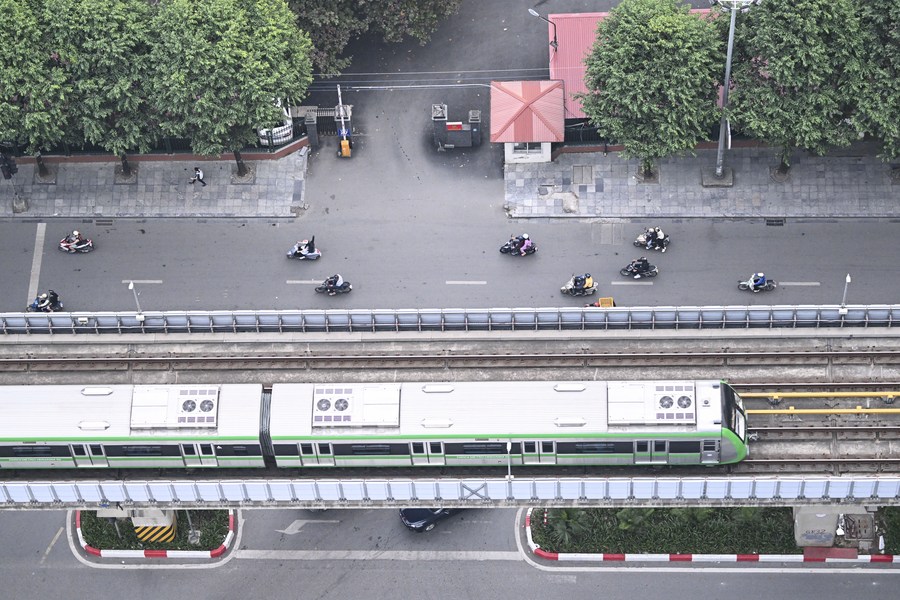
A train runs on the Cat Linh-Ha Dong urban elevated railway in Hanoi, Vietnam, Dec. 9, 2023. (Xinhua/Cheng Yiheng)
As a flagship project of advancing the synergy between the China-proposed Belt and Road Initiative (BRI) and Vietnam's "Two Corridors and One Economic Circle" plan, the 13 km Cat Linh-Ha Dong line with 12 stations covering three districts in Hanoi provides a convenient and comfortable alternative for commuters, as well as a chance to enjoy an overhead view of the capital.
Since its commercial operation in November 2021, the metro has run over 17.5 million passenger trips, and is welcomed by citizens for being eco-friendly and convenient with reasonable ticket prices, said Vu Hong Truong, general director of Hanoi Metro One Member Limited Liability Company.
Another exemplification of green development cooperation is the Chinese-invested Soc Son waste-to-energy plant in Hanoi. It can handle 4,000 tons of trash per day, or over 60 percent of the city's garbage, and has made important contributions to improving the city's appearance and environment.
The construction of the plant has effectively contributed to Vietnam's green energy transition and solved the problem of garbage pollution that had long troubled local people, said Gu Chaoqing, president of the Business Association of China in Vietnam.
Xi's state visit is a great encouragement for the business communities of both countries, Gu said, adding that it will further strengthen bilateral cooperation in economic, trade, investment and connectivity. It will also promote personnel exchanges and create more favorable conditions for business investments and development, benefiting the people of both countries and the region.
PROMISING OUTLOOK
"We will bring more benefits to our neighbors through Chinese modernization, jointly move forward Asia's modernization process, and provide new development opportunities for Vietnam and other Asian countries," Xi said in the signed article.
As Vietnam is mulling incentive packages to attract strategic investors and multinationals for more foreign direct investments, experts have suggested that besides financial incentives, Vietnam should focus on the upgrade of socio-economic infrastructure, the development of a green economy and the facilitation of administrative procedures.

This aerial photo taken on Oct. 16, 2023 shows a China-Vietnam (L) and a China-Laos international cold-chain freight trains pulling out of Yanhe Station of Yuxi City, southwest China's Yunnan Province. (Photo by Chen Chang/Xinhua)
The goal aligns perfectly with the vision of the fast-growing Chinese investment in Vietnam, which ranked third last year and rose to second place in the first nine months of this year with an amount of 2.92 billion dollars.
The Chinese investment is actively adapting to the needs of Vietnam's economic transformation and upgrading, said Chinese Ambassador to Vietnam Xiong Bo, listing high-tech, information and communication, new energy, green development and e-commerce logistics as areas with huge potential.
In September, Vietnamese Prime Minister Pham Minh Chinh called on Chinese enterprises and investors to participate in the investment in and construction of strategic infrastructure projects such as railways and highways in Vietnam.
Sharing a similar view, Xiong said China holds a positive and open attitude towards participating in Vietnam's infrastructure construction. Accelerating the connectivity of transport infrastructure, especially railway and road connectivity, is the focus of cooperation between the two countries under the BRI and the "Two Corridors and One Economic Circle" plan, he added.
While co-chairing the 15th meeting of the Steering Committee for Bilateral Cooperation in the Vietnamese capital Hanoi earlier this month, Chinese Foreign Minister Wang Yi called on the two sides to leverage geographical proximity and industrial complementarity to jointly build a mutually beneficial, stable and unimpeded industrial and supply chain system.
The comprehensive strategic cooperation between the two countries will help both countries jointly advance their modernization with respective features, enrich the choices of modernization for developing countries and bring more benefits to the two peoples, said Chinese foreign ministry spokesperson Wang Wenbin.
Photos
Related Stories
- Interview: Senior Vietnamese official says Xi's visit to further promote Vietnam-China friendship
- Xi calls for building China-Vietnam community with shared future
- Xi arrives in Vietnam for state visit
- Vietnam's farm produce exports to China record speedy growth
- Deepening ties with Beijing in Hanoi's interests
- Xi's Vietnam visit set to elevate ties
Copyright © 2023 People's Daily Online. All Rights Reserved.






